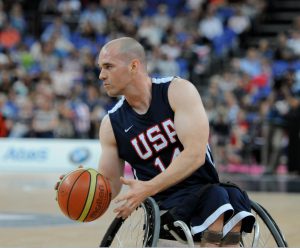Basketball season may have inspired you to take up wheelchair basketball. You may find yourself wondering, however, if wheelchair basketball is right for you and where to start. Look no further! Below are answers to some of the most popular topics on wheelchair basketball—from rules to rear wheel size.
Anyone who has a physical impairment which does not allow them to play able-bodied sports is allowed to play. Typically, this includes spinal cord injuries, spina bifida, amputees and more recently, those who have had knee replacements.
Many of the core concepts in able-bodied basketball are the same in wheelchair basketball. Regulation size, hardwood basketball courts are used in wheelchair basketball and have the same lines (three point, free throw) that you may see on a high school or college court. When it comes to contact, your chair is considered an extension of your body. A certain degree of contact is allowed when you’re playing defense such as setting a pick or boxing out for a rebound.
One rule that sets wheelchair basketball apart is that double dribbling is allowed.
For every dribble, you’re allowed to push twice; if you push three times without dribbling then it’s considered traveling.
Adjustable basketball wheelchairs are great for athletes who are just starting to play basketball, or, if you’re uncertain what your best seating position is. If you’re more experienced and just want to up your game on the court, a fixed basketball wheelchair will deliver more performance. This is because everything is welded to your specifications instead of clamped. A key part in getting a fixed chair to meet your needs and fit properly is to get measured by someone with experience who can used your existing chair as a guide.
 Typical Chair Heights
Typical Chair HeightsBelieve it or not, there are some regulations when it comes to the height of your chair. The tallest that your seat rail can be above the ground is 21 inches.
Players who usually opt for this height are typically amputees and other high functioning players because a good amount of stabilizing muscle groups are needed to effectively play. These players usually play the center position on the court. Athletes with spinal cord injuries, who usually play the guard position, have a typical rear seat height of 15–19”.
Most players prefer double anti-tips because these give more stability and help you tip over less than a single-tip would.
Some players choose a 24” wheel height because they want a quick start (these are the fastest). You’ll need to have a rear seat height of less than 16” for this, though. If you’re looking for the best of both worlds, 25” wheel size will allow you to start fairly quickly and give you more “roll” per push. You can get 25” wheels if your seat-to-floor height is between 16.5”–19”. While not quite as quick as the smaller sizes, centers usually use 26” wheels because their rear seat heights are between 19”–21” and many athletes want to sit as high as possible for rebounds.
You’ll love that the Invacare® Top End® Pro™-2 All Sport Wheelchair not only lets you up your game on the court, but you can use this chair to play any court sport such as tennis, softball or floor hockey during the off-season.
If you need fast adjustments (just 15 minutes) and want the ability to tuck your feet as far back or forward as you want, the Invacare® Top End® Pro™ Basketball Wheelchair is for you.
Thanks a lot for sharing such a great piece of article! I found it a good helpful write-up with a good sound and explanation. Here I have seen some valuable ideas that are definitely helpful for every basketball enthusiast who has a physical impairment. Please keep sharing more updates!